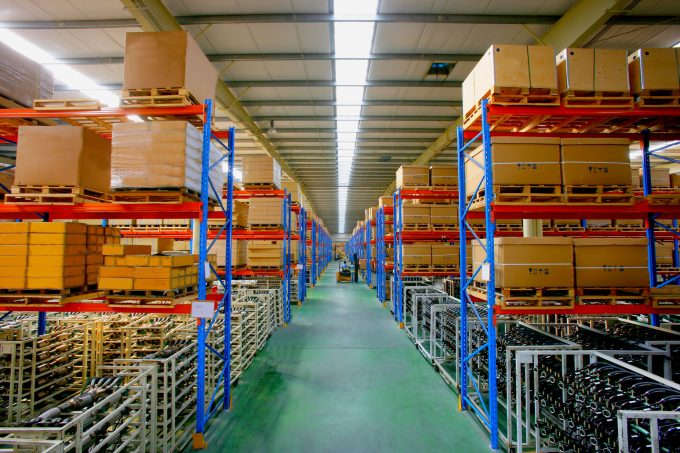As 'gift' season looms, airlines must know exactly what cargo they are carrying
It’s not just the loss of taxes or the import of illegal substances that is ...
GM: RAISING THE ROOF GGM: IN FULL THROTTLE GZIM: MAERSK BOOST KNIN: READ-ACROSSMAERSK: NOT ENOUGHMAERSK: GUIDANCE UPGRADEZIM: ROLLERCOASTERCAT: HEAVY DUTYMAERSK: CATCHING UP PG: DESTOCKING PATTERNSPG: HEALTH CHECKWTC: THE FALLGXO: DEFENSIVE FWRD: RALLYING ON TAKEOVER TALKODFL: STEADY YIELDVW: NEW MODEL NEEDEDWTC: TAKING PROFIT
GM: RAISING THE ROOF GGM: IN FULL THROTTLE GZIM: MAERSK BOOST KNIN: READ-ACROSSMAERSK: NOT ENOUGHMAERSK: GUIDANCE UPGRADEZIM: ROLLERCOASTERCAT: HEAVY DUTYMAERSK: CATCHING UP PG: DESTOCKING PATTERNSPG: HEALTH CHECKWTC: THE FALLGXO: DEFENSIVE FWRD: RALLYING ON TAKEOVER TALKODFL: STEADY YIELDVW: NEW MODEL NEEDEDWTC: TAKING PROFIT

Warehouse rents in the US are rising rapidly as e-commerce gobbles up space faster than it can be replenished.
In some cases, the urge to bring on new capacity seems strangely muted: when it comes to cargo facilities at US airports, there seems to be no hurry to add new or overhaul existing cargo infrastructure, despite serious bottlenecks exposed in last year’s peak season.
Real estate firm CBRE’s Industrial Availability Index was down to 7.3% in the first quarter, which marked 31 consecutive quarters of decline.
On a more granular level, available space was down in 31 US markets, up in 25 and flat in eight.
New capacity coming onstream cannot make up for the rise in demand. CBRE registered 35m sq feet of new space in the first quarter, but the demand was for 42m.
Predictably this is driving up warehouse rents. In major markets – particularly around ports and at ‘last-touch’ warehouses close to town centres for speedy e-commerce deliveries – rents have hit double-digit increases.
Much of this is driven by e-commerce. According to a report by logistics facility developer Prologis, e-commerce accounts for 20% of new leasing activity in the industrial sector, up from 5% less than 10 years ago.
The lack of warehouse capacity is exacerbated by the fact that much existing stock is not suited to e-commerce demand, CBRE diagnosed.
It found a high percentage of facilities outdated and not properly equipped. Out of a total inventory of 9.1bn sq ft, just 11% of it had been built during the past 10 years, and nearly 1bn sq ft is more than 50 years old with clearance heights below 20ft.
This is particularly dire in the north-east, where markets with the highest average age of facilities are New Jersey, Pittsburgh, Boston, Philadelphia and Cleveland.
CBRE did not focus particularly on airports, but it is no secret that much of the cargo infrastructure at US gateways is in the same state. Due to a lack of development in the past decade, many airports are near capacity and struggled to cope with volumes during last year’s peak season.
However, this situation has not sparked a new round of air cargo facility development. Ray Brimble, CEO of aviation facility developer Lynxs, is surprised.
“I would have thought there would be more activity, but so far we have not seen that much; less than I expected,” he said.
Indicators point to sustained growth, which should generate enough confidence in the market to build new facilities, he added. Moreover, interest rates as well as construction costs are rising, raising the prospect of higher development costs down the road.
On the other hand, Lynxs has heard from tenants that their business is growing and may require more space. This may stymie plans to redevelop some cargo facilities, Mr Brimble believes.
He thinks the main factor holding airports back is the question mark over the evolution of requirements from the e-commerce sector. Some are probably waiting to see a clearer picture of what kind of facility this traffic will require, he said.
Most likely those changes will not only affect the flow of cargo through warehouses and airside access, but also requirements on the landside.
One possible scenario is a rise in the number of truck calls, which would put more strain on the roads around airports.
Already congestion on access roads has forced some major European hubs to take steps to steer truck access to their cargo areas. At Frankfurt, two handlers recently introduced a regime that requires truckers to book a slot instead of just turning up at their facilities.
Such solutions, that employ software, would be easier to implement than tearing down or overhauling existing cargo terminals, Mr Brimble said. However, he has seen scant attention paid to this in North America.
“It seems nobody is rushing out for such solutions,” he said, adding that importers and forwarders had cause for concern regarding the next spike in airfreight volumes.
Comment on this article
Hannan Ahmad
June 02, 2018 at 4:58 pmGiven the public interest of buying everything online, e-commerce industry has boomed a lot fastly as compared to the previous years. Because of this boom, the need of more warehouses has increased but due to the shortage of space, the rent on warehouses has been increased around the globe. The world right now has 9 markets out of which American owns 6 and the rent increased to 9.9 percent in 2015. As result shippers and investors in the US are having quite a hard time in securing warehouses and distributing space because now they have to pay a lot more.